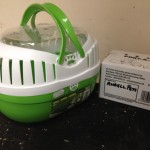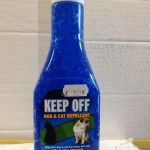Moving house is reckoned to be one of the most stressful things an average person has to do. It can also be quite stressful for your pets but you can reduce the sress (for them and you) with a few simple tips.
- “Failing to plan is planning to fail” is an old cliched saying but no less true for all that. Make sure you have any equipment (suitable carriers, packing material etc.) ready before the big day. Hunting around at the last minute will raise your sress levels through the roof and your animal will suffer the consequences of you rushing, using less than ideal travel boxes or even forgetting the poor thing altogether (it does happen). So make sure you have considered what you are going to use to transport your pet and timing the move of the animal with the move of its enclosure. There’s not a lot of point turning up at your new house with bags of tropical fish when the tank is still with the moving company and won’t be there until tommorrow!
- Use a suitable container to move your animal. Often people think they need to get the largest container they can. This is often the wrong thing to do. During the move the animal will just rattle around in a large box and get injured. A small container with suitable packing material (a small animal carrier filled with shredded paper for a hamster for instance) is much more desirable. Remember that animals chew things so if you are moving any distance then a cardboard carrier is not enough, it won’t survive the journey.

- Make sure you know where in your new house or garden the animal’s enclosure is going to go. It can have a large effect on the wellbeing of your pet. Our rabbits are on a well sheltered patio with walls on three sides and a dwarf wall on the fourth. If we moved I doubt the new area would be as sheltered which would mean we would have to reconsider our housing of the animals over the coldest winter periods. Would you have somewhere to put them in your new house?
- Don’t trust the animals to the movers. They are best transported with you, secured in place in your car. You can control the movement, security and environment to ensure they are safe and well at the end of the journey.
So you’ve moved and you need to set up your pet in their new home. My advice is do this first, before you start unpacking everything else. You want the animal in its transport box for as little time as possible. The exception to this is the dog and cat. These are best not under foot whilst you are unpacking so if you can get someone to look after them for a couple of days it would be better, or alternatively use a good boarding establishment. Then you can get on and unpack in peace and not in pieces, after you’ve tripped over the dog for the fourth time or worse, left the door open and the dog is out.
Obviously use the move as an opportuntiy to completely clean any enclosures you have and start your pet’s life in your new home in a nice clean enclosure. It is also easier to move an empty cage.
Right, so some specific advice on certain animals.
- Dogs. Easy yes? Just put on the lead, jump in the car and go. Well if, like me, you rarely take the dogs in the car, you are probably not prepared. Dogs should be secured. A travel cage is ideal or you could use a travel harness or an adaptor for you existing harness to strap the dog to the car’s seatbelt restraints.
 If you have an accident on the way the dog could kill you if not restrained (the car will stop suddenly, the dog won’t). I’ll assume you have unpacked everything before the dog arrives at the new house (see above). It is all going to be very new and exiting for him/her. The more old possesions around the more quickly settled the dog will be. If you can and the garden is secure, leave the back door open and let them explore. Exitable dogs in a new environment like to pee to mark their new territory, better outside than in. Do double check your new garden for security though, it’s surprising what they can get out of. However dogs are not “free to roam” animals, cats are.
If you have an accident on the way the dog could kill you if not restrained (the car will stop suddenly, the dog won’t). I’ll assume you have unpacked everything before the dog arrives at the new house (see above). It is all going to be very new and exiting for him/her. The more old possesions around the more quickly settled the dog will be. If you can and the garden is secure, leave the back door open and let them explore. Exitable dogs in a new environment like to pee to mark their new territory, better outside than in. Do double check your new garden for security though, it’s surprising what they can get out of. However dogs are not “free to roam” animals, cats are. - Cats. The biggest problem with a cat if you let it outside, is they may go missing. Cats are territorial animals. They are famous for marking their territories and defending them. If you just let your cat out into another cat’s territory the other cat is going to see it off. This may mean it trying to return to its old territory. When my sister moved a few years ago it wasn’t very far. Her cat repeatedly went back to the old house, not because it was being fed there, the new owners were not cat lovers, but because this was her territory and there were other cats in the area of the new house. Keep your cat in for a couple of weeks. Try to force other cats away from your garden and immediate area around your house. This can be done by using special products that overpower the marking scent of cats.
 They will try to battle the new smell but will eventually realise they are losing. To a cat the strongest smell wins the war so once they know they have lost to the product they move on. The territory is then free for your cat to move into.
They will try to battle the new smell but will eventually realise they are losing. To a cat the strongest smell wins the war so once they know they have lost to the product they move on. The territory is then free for your cat to move into. - Small mammals. Small mammal = small travel box. You don’t want your pet rat sliding around bashing himself against the side of a large container as your husband/wife gets used to the brakes on your car for instance (yes, that is from experience). It is best, when you have rehoused them at the other end to leave them alone for 24 hours, as you would when you first get one, to settle in to the new environment. Trailers are best avoided, the exhaust fumes from your car pumped into the trailer, well obvious really.
- Birds. The main thing with birds is that you are quite probably going to want to decorate your new house. Fumes and birds don’t mix. Birds have very sensitive respiratory systems. I have had customers who have lost birds inexplicably then when we have gone through everything with them have realised that the landlord had contractors painting the exterior windows and they had them open because it was summer. They found the smell inconvenient at the time, the birds found it fatal. So if you are decorating, find somewhere else to house the bird (and NOT in the kitchen – teflon non stick pans give off toxic fumes). The same is true for fish by the way – most chemical products tell you they are toxic to aquatic environments, they don’t make it clear this can include the fumes.
- Reptiles. Probably one of the easiest animals to move. They can be transported in a suitably sized plastic tub or box (polystyrene outer if you are moving far, to steady the temperature). Their vivariums are generally well insulated and will already have the correct equipment to control heat, light and humidity (I would hope!). One thing to think about however is the change in the general environment in the new house and how this is effecting the conditions in the vivarium. I have a bull snake in my bedroom. I do not have a thermostat controlling the heat source. However I have had this snake in this location and this viv. for 9 years and know that the temperature remains very stable throughought the year (because of my wifes intolerance of any variation – windows wide open all summer and heating on for the rest of the year!!) and it never gets too hot in the viv., even in the height of summer (it is nowhere near a window and is one of the coolest rooms in the house). If I were to move the viv. to another location I could not guarantee this and would have to invest in a thermostat to prevent overheating. Keep a check on conditions when you move in and as the weather changes, it will probalby effect the conditions inside the vivarium and change them from what you are used to.
- Invertebrates. The same is true for most invertebrates (insects, spiders etc.). On top of this they do not travel well. They can become dissicated very easily if it is particularly hot or become chilled if it is cold. You need to manage this by transorting them in a controlled environment (your car), in a container where the humidity and temperature are not going to vary too much and making sure the new location does not adversley effect them. If they do get cold they will become inactive. It is very important that you do not rewarm them too quickly. Just leave them at normal room tepmperature to warm up slowly. If you put them under a heat source the rapid change in temperature could stress and kill them quite quickly.

- Fish. One of the most difficult to move. You need to plan this carefully.
 At the last minute bag up the fish. Get some fish transport bags from us in our pet shop Gloucester and part fill them with water from your tank. Net the fish and place them in the bags – no more than half a dozen per bag is good. Blow into the bag (not too close, you want clean air going in, not your exhalations!) Twist the tops and secure with a ruber band. Place the fish bags in a polystyrene box with a lid. Then bag up as much of your tank water as you can so you don’t have to use too much fresh water at the other end to refill it.The less change in water quality the better. Bagging the water rather than trying to transport it in large tanks or containers does two things. It reduces the risk of a large loss of water should a container get damaged and makes the load a lot more stable. Large amounts of water in a container will move around alot. In the case of large tanks enough to destabilise a car. Bagging up baffles to water so less movement occurs going round corners. Put the water bags in a polystyrene box as well – not too many per box, a litre of water weighs at least 1kg. You can get polystyrene boxes from us, our fish and frozen reptile food is delivered in them. Leave the tank gravel wet and if possible submerge the filter to keep it wet. At the other end, get the tank located, water in the tank (top up with a little fresh but don’t worry about having the tank full yet). Get everything plugged in and running and then check the temperature. If you got it right this should still be OK. If you haven’t travelled far you may want to leave it to clear a bit before putting the fish in but if you have had the fish in bags for any length of time you want to get them in the tank. Put the fish bags in the tank water for 10 – 15 minutes to equalise the temperature (not necessary if you measure the temperature and it is the same). Then net the fish out of the bags into the tank. Do not tip the fish bag water into the tank – it will contain too much fish waste (ammonia) and you don’t want to overload your tank after the natural disposal system (bacteria) has been disturbed. When the tank has settled down you can top it up with fresh water. Remember that “tap” water is not the same at every tap. Some (like Birmingham) is naturally very soft upper river valley water, some (like Coventry) is semi hard lowland river water and some (like parts of Gloucestershire) is very hard, underground water. So you could be moving from one extreme to another and this will effect your fish, hense the need for gradual change of water conditions and saving as much of your old water as possible.
At the last minute bag up the fish. Get some fish transport bags from us in our pet shop Gloucester and part fill them with water from your tank. Net the fish and place them in the bags – no more than half a dozen per bag is good. Blow into the bag (not too close, you want clean air going in, not your exhalations!) Twist the tops and secure with a ruber band. Place the fish bags in a polystyrene box with a lid. Then bag up as much of your tank water as you can so you don’t have to use too much fresh water at the other end to refill it.The less change in water quality the better. Bagging the water rather than trying to transport it in large tanks or containers does two things. It reduces the risk of a large loss of water should a container get damaged and makes the load a lot more stable. Large amounts of water in a container will move around alot. In the case of large tanks enough to destabilise a car. Bagging up baffles to water so less movement occurs going round corners. Put the water bags in a polystyrene box as well – not too many per box, a litre of water weighs at least 1kg. You can get polystyrene boxes from us, our fish and frozen reptile food is delivered in them. Leave the tank gravel wet and if possible submerge the filter to keep it wet. At the other end, get the tank located, water in the tank (top up with a little fresh but don’t worry about having the tank full yet). Get everything plugged in and running and then check the temperature. If you got it right this should still be OK. If you haven’t travelled far you may want to leave it to clear a bit before putting the fish in but if you have had the fish in bags for any length of time you want to get them in the tank. Put the fish bags in the tank water for 10 – 15 minutes to equalise the temperature (not necessary if you measure the temperature and it is the same). Then net the fish out of the bags into the tank. Do not tip the fish bag water into the tank – it will contain too much fish waste (ammonia) and you don’t want to overload your tank after the natural disposal system (bacteria) has been disturbed. When the tank has settled down you can top it up with fresh water. Remember that “tap” water is not the same at every tap. Some (like Birmingham) is naturally very soft upper river valley water, some (like Coventry) is semi hard lowland river water and some (like parts of Gloucestershire) is very hard, underground water. So you could be moving from one extreme to another and this will effect your fish, hense the need for gradual change of water conditions and saving as much of your old water as possible.
So there you go, a few things to think about when you move house with your animals. If you want any specific advice on this subject or any other give us a call or pop into the shop. We will be happy to help where we can (I’ve never kept ostritches so I can’t really help there. That said I do know someone who has, so I could probably find out).

